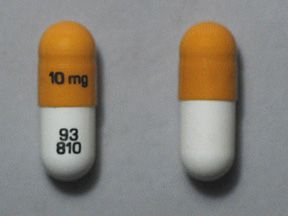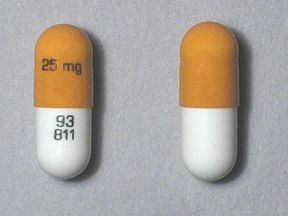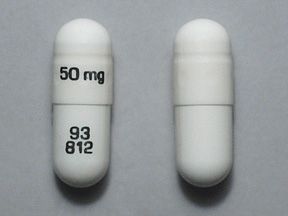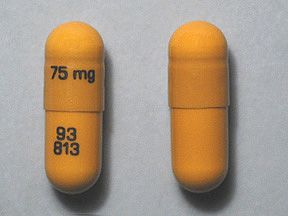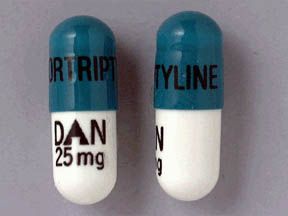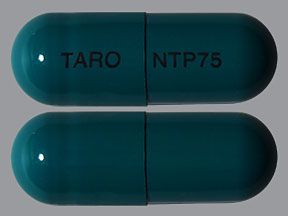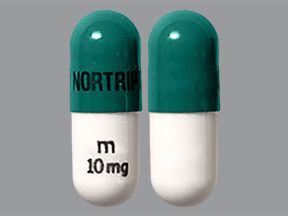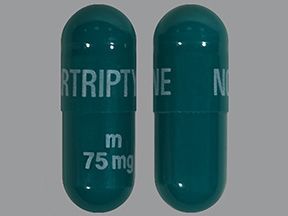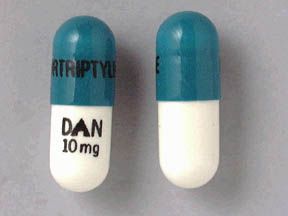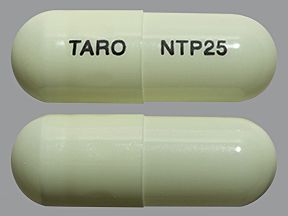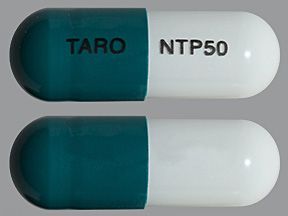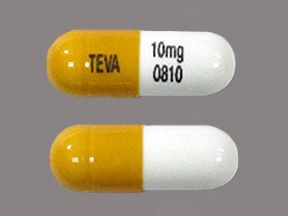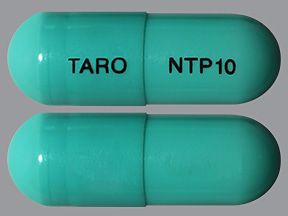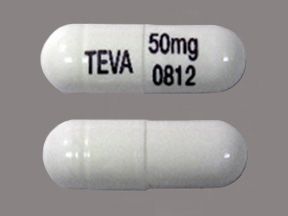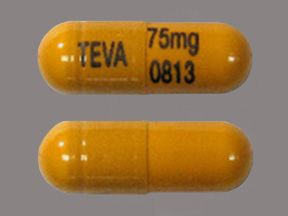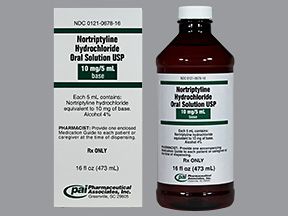Highlights for nortriptyline
- Nortriptyline oral capsule is available as both a generic and brand-name drug. Brand name: Pamelor.
- Nortriptyline comes as an oral capsule and an oral solution.
- Nortriptyline oral capsule is used to treat depression.
FDA warning: Suicide risk
- This drug has a black box warning. This is the most serious warning from the Food and Drug Administration (FDA). A black box warning alerts doctors and patients about drug effects that may be dangerous.
- Nortriptyline may increase the risk of suicidal thoughts and behavior for people younger than 24 years. Having depression and psychiatric problems puts you at higher risk of suicide. Your doctor will monitor you for any changes in your depression symptoms and any unusual behavior or thoughts about suicide.
Other warnings
- Cardiovascular problems warning: Taking nortriptyline could put you at risk of a fast heart rate, heart attack, stroke, and other circulatory problems. Tell your doctor if you have any heart problems before taking nortriptyline. Do not take nortriptyline if you recently had a heart attack.
- Increased eye pressure warning: Nortriptyline may increase pressure in your eyes. This may cause glaucoma in people who are already at risk of glaucoma.
- Serotonin syndrome warning: This drug may cause a condition called serotonin syndrome. The symptoms of serotonin syndrome include hallucinations and delusions, agitation, coma, fast heart rate, changes in blood pressure, dizziness, loss of consciousness, seizures, shakiness, muscle tremors or stiff muscles, sweating, nausea, and vomiting.
- Dementia warning:
Research has indicated that this type of medication can cause effects similar to those caused by drugs called anticholinergics. This can raise your risk of dementia.
Nortriptyline is a prescription drug. It comes as an oral capsule and an oral solution.
Nortriptyline oral capsule is available as the brand-name drug Pamelor. It’s also available as a generic drug. Generic drugs usually cost less than the brand-name version. In some cases, they may not be available in all strengths or forms as the brand-name drug.
Why it’s used
Nortriptyline is used to treat depression.
Nortriptyline may be used as part of a combination therapy. This means you may need to take it with other medications.
How it works
Nortriptyline belongs to a class of drugs called tricyclic antidepressants. A class of drugs is a group of medications that work in a similar way. These drugs are often used to treat similar conditions.
Nortriptyline works on your central nervous system to increase the level of certain chemicals in your brain. This helps relieve your depression.
Nortriptyline oral capsule may cause drowsiness. It may also cause other side effects.
More common side effects
Some of the more common side effects that can occur with use of nortriptyline include:
- low blood pressure
- high blood pressure
- confusion (mainly in seniors)
- sleep problems
- shakiness
- dry mouth
- blurry vision
- constipation
- skin rash
- hives
- itching
- skin sensitivity to light
- nausea
- vomiting
- diarrhea
- stomach cramps
- decreased sexual desire
- unexpected weight loss or gain
- sweating
- headache
If these effects are mild, they may go away within a few days or a couple of weeks. If they’re more severe or don’t go away, talk to your doctor or pharmacist.
Serious side effects
Call your doctor right away if you have serious side effects. Call 911 if your symptoms feel life-threatening or if you think you’re having a medical emergency. Serious side effects and their symptoms can include the following:
- Psychiatric problems. Symptoms can include:
- suicidal thoughts and behavior
- depression
- anxiety
- restlessness
- panic attacks
- sleep disturbances such as nightmares or insomnia (trouble sleeping)
- disorientation
- changes in behavior
- rapid speech and increased activity (signs of mania)
- Fast heart rate
- Heart attack. Symptoms can include:
- chest pain
- shortness of breath
- pain or pressure in your upper body
- Stroke. Symptoms can include:
- weakness in one part or side of your body
- slurred speech or trouble speaking
- Inability to urinate
- Seizures
- Drowsiness
- Serotonin syndrome. Symptoms can include:
- hallucinations
- agitation
- delusions
- changes in blood pressure level
- fast heart rate
- loss of consciousness
- sweating
- muscle tremors or stiff muscles
- shakiness
- nausea and vomiting
- Increased eye pressure. Symptoms can include:
- eye pain
- swelling and redness near your eyes
- changes in vision
Disclaimer: Our goal is to provide you with the most relevant and current information. However, because drugs affect each person differently, we cannot guarantee that this information includes all possible side effects. This information is not a substitute for medical advice. Always discuss possible side effects with a healthcare provider who knows your medical history.
Nortriptyline oral capsule can interact with other medications, vitamins, or herbs you may be taking. An interaction is when a substance changes the way a drug works. This can be harmful or prevent the drug from working well.
To help avoid interactions, your doctor should manage all of your medications carefully. Be sure to tell your doctor about all medications, vitamins, or herbs you’re taking. To find out how this drug might interact with something else you’re taking, talk to your doctor or pharmacist.
Examples of drugs that can cause interactions with nortriptyline are listed below.
Drugs you should not use with nortriptyline
Do not take these drugs with nortriptyline. Doing so can cause dangerous side effects in your body. Examples of these drugs include:
- Monoamine oxidase inhibitors (MAOIs) and drugs with MAOI effects such as phenelzine, tranylcypromine, selegiline, linezolid, and methylene blue
- Taking these drugs with nortriptyline can cause serotonin syndrome. Wait at least 14 days after stopping nortriptyline before taking an MAOI, and vice versa.
- Increased side effects from nortriptyline: Taking nortriptyline with certain medications raises your risk of side effects from nortriptyline. This is because the amount of nortriptyline in your body may be increased. Examples of these drugs include:
- Cimetidine
- Increased side effects of nortriptyline can include headache, fast heart rate, and drowsiness.
- Cytochrome P450 2D6 inhibitors such as quinidine, sertraline, paroxetine, and fluoxetine (Note: You might need to wait about 5 weeks after stopping fluoxetine before starting nortriptyline.)
- Increased side effects of nortriptyline can include headache, fast heart rate, and drowsiness. Your doctor may start you at a lower dosage of nortriptyline if you’re taking it with one of these medications.
- Cimetidine
- Increased side effects from other drugs: Taking nortriptyline with certain medications raises your risk of side effects from these drugs. Examples of these drugs include:
- Reserpine
- Increased side effects of this drug can include higher blood pressure and heart rate, and trouble sleeping.
- Drugs with anticholinergic effects such as diphenhydramine, loratadine, oxybutynin, solifenacin, and olanzapine
- Increased side effects of these drugs can include changes in your blood pressure, urinary retention, and increased heart rate. Your doctor may have to adjust your dosages if you take one of these drugs with nortriptyline.
- Sympathomimetic drugs such as epinephrine, ephedrine, and norepinephrine
- Increased side effects of these drugs can include changes in your blood pressure, headache, and increased heart rate. Your doctor may have to adjust your dosages if you take one of these drugs with nortriptyline.
- Chlorpropamide
- Increased side effects of this drug can include low blood sugar levels in people with diabetes.
- Reserpine
- Increased side effects from both drugs: Taking nortriptyline with certain medications raises your risk of side effects. This is because nortriptyline and these other medications can cause the same side effects. As a result, these side effects can be increased. Examples of these drugs include:
- Serotonin reuptake inhibitors (SSRIs) such as sertraline, fluoxetine, paroxetine, and venlafaxine
- Taking these medications with nortriptyline increases your risk of serotonin syndrome. If you need to take any of these drugs with nortriptyline, your doctor may adjust your dosage of both drugs.
- Norepinephrine reuptake inhibitors (SNRIs) such as duloxetine and desvenlafaxine
- Taking these medications with nortriptyline increases your risk of serotonin syndrome. If you need to take any of these drugs with nortriptyline, your doctor may adjust your dosage of both drugs.
- Triptans, such as sumatriptan and naratriptan
- Taking these medications with nortriptyline increases your risk of serotonin syndrome. If you need to take any of these drugs with nortriptyline, your doctor may adjust your dosage of both drugs.
- Other drugs, such as fentanyl, lithium, tramadol, tryptophan, buspirone, and St. John’s wort
- Taking these medications with nortriptyline increases your risk of serotonin syndrome. If you need to take any of these drugs with nortriptyline, your doctor may adjust your dosage of both drugs.
- Serotonin reuptake inhibitors (SSRIs) such as sertraline, fluoxetine, paroxetine, and venlafaxine
Interactions that increase your risk of side effects
Disclaimer: Our goal is to provide you with the most relevant and current information. However, because drugs interact differently in each person, we cannot guarantee that this information includes all possible interactions. This information is not a substitute for medical advice. Always speak with your healthcare provider about possible interactions with all prescription drugs, vitamins, herbs and supplements, and over-the-counter drugs that you are taking.
Call your doctor if you notice your depression getting worse while you take this drug. Also call your doctor if you have suicidal thoughts.
Nortriptyline oral capsule comes with several warnings.
Allergy warning
Nortriptyline can cause a severe allergic reaction. Symptoms can include:
- skin rash, hives, itching, and sun sensitivity
- swelling of your body or face and tongue
- fever
If you have an allergic reaction, call your doctor or local poison control center right away. If your symptoms are severe, call 911 or go to the nearest emergency room.
Don’t take this drug again if you’ve ever had an allergic reaction to it. Taking it again could be fatal (cause death).
Alcohol interaction warning
The use of drinks that contain alcohol together with nortriptyline can lead to suicidal thoughts and attempts. This risk is higher if you have a history of suicidal thoughts and trouble controlling your emotions. If you drink alcohol, talk to your doctor.
Warnings for people with certain health conditions
For people with heart and other cardiovascular disorders: Taking this drug may increase your risk of stroke and heart problems, such as irregular heart rhythm or heart attack. Do not take this drug if you’re recovering from a recent heart attack.
For people with bipolar disorder: Before starting therapy with antidepressants, it’s important for your doctor to check your risk of bipolar disorder. If you have bipolar disorder that’s not being treated, taking nortriptyline can make your condition worse.
For people with a history of seizures: Taking this drug may increase your risk of seizures. If you have a history of seizures, your doctor will monitor you more closely. If you have a seizure while taking nortriptyline, stop taking it and call your doctor.
For people with glaucoma or increased eye pressure: Taking this drug could increase the pressure in your eyes. If you have a history of glaucoma or increased eye pressure, your doctor will monitor you more closely while you take nortriptyline.
For people with urinary retention: Taking this drug could make symptoms of urinary retention worse. If you have a history of urinary retention, your doctor will monitor you more closely while you take nortriptyline.
For people with hyperthyroidism or who take thyroid medication: Taking this drug could increase heart rhythm irregularity for you. Your doctor will need to monitor you very closely.
Warnings for other groups
For pregnant women: It’s unclear if nortriptyline is safe in pregnancy. Talk to your doctor if you’re pregnant or planning to become pregnant. This drug should be used only if the potential benefit justifies the potential risk to the fetus.
For women who are breastfeeding: It’s unclear if nortriptyline is safe when breastfeeding. Talk to your doctor if you breastfeed your child. You may need to decide whether to stop breastfeeding or stop taking this medication.
For seniors: Seniors might experience more side effects from nortriptyline. Confusion, irregular heartbeat, and changes in blood pressure have been noticed more commonly in seniors. Your doctor might start you on a lower dose.
For children: This drug hasn’t been studied in children. It may cause suicidal thoughts and behavior in people younger than 24 years during the first months of use.
This dosage information is for nortriptyline oral capsule. All possible dosages and drug forms may not be included here. Your dosage, drug form, and how often you take the drug will depend on:
- your age
- the condition being treated
- how severe your condition is
- other medical conditions you have
- how you react to the first dose
Forms and strengths
Generic: Nortriptyline
- Form: oral capsule
- Strengths: 10 mg, 25 mg, 50 mg, 75 mg
Brand: Pamelor
- Form: oral capsule
- Strengths: 10 mg, 25 mg, 50 mg, 75 mg
Dosage for depression
Adult dosage (ages 18–64 years)
- Recommended dosage: 25 mg, three to four times per day or once daily; start at the low level and increase as required.
- Maximum dosage: 150 mg per day.
Child dosage (ages 0–17 years)
This drug is not recommended for use in children.
Senior dosage (ages 65 years and older)
- Recommended dosage: 30–50 mg, once per day or in divided doses; start at the low level and increase as required.
- Maximum dosage: 150 mg per day.
Disclaimer: Our goal is to provide you with the most relevant and current information. However, because drugs affect each person differently, we cannot guarantee that this list includes all possible dosages. This information is not a substitute for medical advice. Always to speak with your doctor or pharmacist about dosages that are right for you.
Nortriptyline oral capsule is used for long-term treatment. It comes with risks if you don’t take it as prescribed.
If you stop taking the drug or don’t take it at all: Your depression won’t improve or might even worsen.
If you miss doses or don’t take the drug on schedule: Your medication may not work as well or may stop working completely. For this drug to work well, a certain amount needs to be in your body at all times.
If you take too much: You could have dangerous levels of the drug in your body. Symptoms of an overdose of this drug can include:
- irregular heart rhythm
- very low blood pressure
- seizures
If you think you’ve taken too much of this drug, call your doctor or seek guidance from the American Association of Poison Control Centers at 800-222-1222 or through their online tool. But if your symptoms are severe, call 911 or go to the nearest emergency room right away.
What to do if you miss a dose: Take your dose as soon as you remember. But if you remember just a few hours before your next scheduled dose, take only one dose. Never try to catch up by taking two doses at once. This could result in dangerous side effects.
How to tell if the drug is working: Your symptoms of depression should get better or be more controlled. It may take a month of treatment before you notice that your depression is getting better.
Keep these considerations in mind if your doctor prescribes nortriptyline oral capsules for you.
General
- You can take nortriptyline with or without food.
- Don’t cut or crush the capsule.
Storage
- Store nortriptyline at room temperature between 68°F and 77°F (20°C and 25°C).
- Don’t store the capsules in moist or damp areas, such as bathrooms.
Travel
When traveling with your medication:
- Always carry your medication with you. When flying, never put it into a checked bag. Keep it in your carry-on bag.
- Don’t worry about airport X-ray machines. They can’t hurt your medication.
- You may need to show airport staff the pharmacy label for your medication. Always carry the original prescription-labeled container with you.
- Don’t put this medication in your car’s glove compartment or leave it in the car. Be sure to avoid doing this when the weather is very hot or very cold.
Clinical monitoring
Your doctor will monitor you for side effects while you take nortriptyline. Your doctor may also monitor:
- your blood levels of nortriptyline, if you’re taking more than 100 mg per day
- your symptoms of depression
Sun sensitivity
This drug may make your skin more sensitive to the sun. Be sure to use sunscreen or wear protective clothing to prevent sunburn.
Refills
A prescription for this drug is refillable. You shouldn’t need a new prescription for this drug to be refilled. Your doctor will write the number of refills authorized on your prescription.
There are other drugs available to treat your condition. Some may be better suited for you than others. Talk to your doctor about other drug options that may work for you.
Disclaimer: Healthline has made every effort to make certain that all information is factually correct, comprehensive, and up-to-date. However, this article should not be used as a substitute for the knowledge and expertise of a licensed healthcare professional. You should always consult your doctor or other healthcare professional before taking any medication. The drug information contained herein is subject to change and is not intended to cover all possible uses, directions, precautions, warnings, drug interactions, allergic reactions, or adverse effects. The absence of warnings or other information for a given drug does not indicate that the drug or drug combination is safe, effective, or appropriate for all patients or all specific uses.

